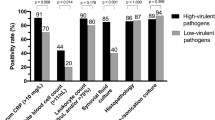Abstract
Background
Intraoperative Gram stains have a reported low sensitivity but high specificity when used to help diagnose periprosthetic infections. In early 2008, we recognized an unexpectedly high frequency of apparent false-positive Gram stains from revision arthroplasties.
Questions/purposes
The purpose of this report is to describe the cause of these false-positive test results.
Methods
We calculated the sensitivity and specificity of all intraoperative Gram stains submitted from revision arthroplasty cases during a 3-month interval using microbiologic cultures of the same samples as the gold standard. Methods of specimen harvesting, handling, transport, distribution, specimen processing including tissue grinding/macerating, Gram staining, and interpretation were studied. After a test modification, results of specimens were prospectively collected for a second 3-month interval, and the sensitivity and specificity of intraoperative Gram stains were calculated.
Results
The retrospective review of 269 Gram stains submitted from revision arthroplasties indicated historic sensitivity and specificity values of 23% and 92%, respectively. Systematic analysis of all steps of the procedure identified Gram-stained but nonviable bacteria in commercial broth reagents used as diluents for maceration of periprosthetic membranes before Gram staining and culture. Polymerase chain reaction and sequencing showed mixed bacterial DNA. Evaluation of 390 specimens after initiating standardized Millipore filtering of diluent fluid revealed a reduced number of positive Gram stains, yielding 9% sensitivity and 99% specificity.
Conclusions
Clusters of false-positive Gram stains have been reported in other clinical conditions. They are apparently rare related to diagnosing periprosthetic infections but have severe consequences if used to guide treatment. Even occasional false-positive Gram stains should prompt review of laboratory methods. Our observations implicate dead bacteria in microbiologic reagents as potential sources of false-positive Gram stains.



Similar content being viewed by others
References
Atkins BL, Athanasou N, Deeks JJ, Crook DWM, Simpson H, Peto TEA, McLardy-Smith P, Berendt AR. Prospective evaluation of criteria for microbiological diagnosis of prosthetic-joint infection at revision arthroplasty. J Clin Microbiol. 1998;36:2932–2939.
Banit DM, Kaufer H, Hartford JM. Intraoperative frozen section analysis in revision total joint arthroplasty. Clin Orthop Relat Res. 2002;401:230–238.
Barrack RL, Jennings RW, Wolfe MW, Bertot AJ. The value of preoperative aspiration before total knee revision. Clin Orthop Relat Res. 1997;345:8–16.
Bauer TW, Parvizi J, Kobayashi N, Krebs V. Diagnosis of periprosthetic infection. J Bone Joint Surg Am. 2006;88:869–882.
Blot F, Raynard B, Chachaty E, Tancrede C, Antoun S, Nitenberg G. Value of Gram stain examination of lower respiratory tract secretions for early diagnosis of nosocomial pneumonia. Am J Respir Crit Care Med. 2000;160:1731–1737.
Chimento GF, Finger S, Barrack RL. Gram stain detection of infection during revision arthroplasty. J Bone Joint Surg Br. 1996;78:838–839.
Della Valle C, Scher DM, Kim YH, Oxley CM, Desai P, Zuckerman JD, DeCesare PE. The role of intraoperative Gram stain in revision total joint arthroplasty. J Arthroplasty. 1999;14:500–504.
Ericsson CD, Carmichael M, Pickering LK, Mussett R, Kohl S. Erroneous diagnosis of meningitis due to false-positive Gram stains. South Med J. 1978;71:1524–1525.
Ghanem E, Ketonis C, Restrepo C, Joshi A, Barrack R, Parvizi J. Periprosthetic infection: where do we stand with regard to Gram stain? Acta Orthop. 2009;80:37–40.
Hoke CH, Batt JM, Mirrett S, Cox RL, Reller B. False-positive Gram-stained smears. JAMA. 1979;241:478–479.
Keighley MRB, McLeish AR, Bishop HM, Burdon DW, Quoraishi AH, Oates GD, Dorricott NJ, Alexander-Williams J. Identification of the presence and type of biliary microflora by immediate Gram stains. Surgery. 1977;81:469–472.
Ko PS, Ip D, Chow KP, Cheung F, Lee OB, Lam JJ. The role of intraoperative frozen section in decision making in revision hip and knee arthroplasty in a local community hospital. J Arthroplasty. 2005;20:189–195.
Kobayashi N, Procop GW, Krebs V, Kobayashi H, Bauer TW. Molecular identification of bacteria from aseptically loose implants. Clin Orthop Relat Res. 2008;466:1716–1725.
Kraemer WJ, Saplys R, Waddell JP, Morton J. Bone scan, gallium scan and hip aspiration in the diagnosis of infected total hip arthroplasty. J Arthroplasty. 1993;8:611–615.
Morgan PM, Sharkey P, Ghanem E, Parvizi J, Clohisy JC, Burnett RSJ, Barrack RL. The value of intraoperative Gram stain in revision total knee arthroplasty. J Bone Joint Surg Am. 2009;91:2124–2129.
Muscher DM, Schell RF. False-positive Gram stains of cerebrospinal fluid. Ann Intern Med. 1973;79:603–604.
Parvizi J, Ghanem E, Menashe S, Barack BL, Bauer TW. Periprosthetic infection: what are the diagnostic challenges? J Bone Joint Surg Am. 2006;88:138–147.
Southern PM Jr, Colvin DD. Pseudomeningitis again. Association with cytocentrifuge funnel and Gram-stain reagent contamination. Arch Pathol Lab Med. 1996;120:456–458.
Spangehl MJ, Masterson E, Masri BA, O’Connell JX, Duncan CP. The role of intraoperative Gram stain in the diagnosis of infection during total hip arthroplasty. J Arthroplasty. 1999;14:952–956.
Willcox JR, Adler MW, Belsey EM. Observer variation in the interpretation of Gram-stained urethral smears: implications for the diagnosis of non-specific urethritis. Br J Vener Dis. 1981;57:134–136.
Acknowledgments
We thank Geraldine Hall, PhD, and Gary Procop, MD, MS, for their guidance during the course of this study and formulation of the manuscript.
Author information
Authors and Affiliations
Corresponding author
Additional information
Each author certifies that he or she has no commercial associations (eg, consultancies, stock ownership, equity interest, patent/licensing arrangements, etc) that might pose a conflict of interest in connection with the submitted article.
About this article
Cite this article
Oethinger, M., Warner, D.K., Schindler, S.A. et al. Diagnosing Periprosthetic Infection: False-positive Intraoperative Gram Stains. Clin Orthop Relat Res 469, 954–960 (2011). https://doi.org/10.1007/s11999-010-1589-9
Published:
Issue Date:
DOI: https://doi.org/10.1007/s11999-010-1589-9




